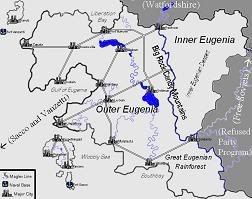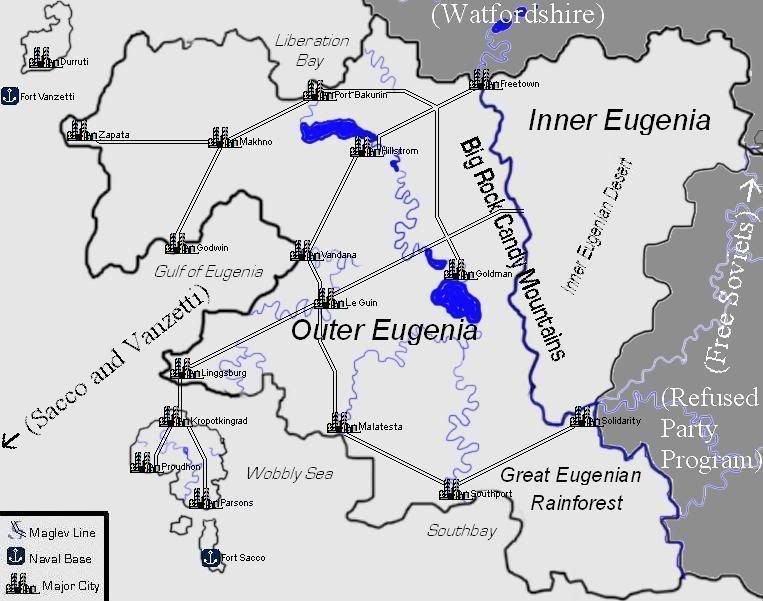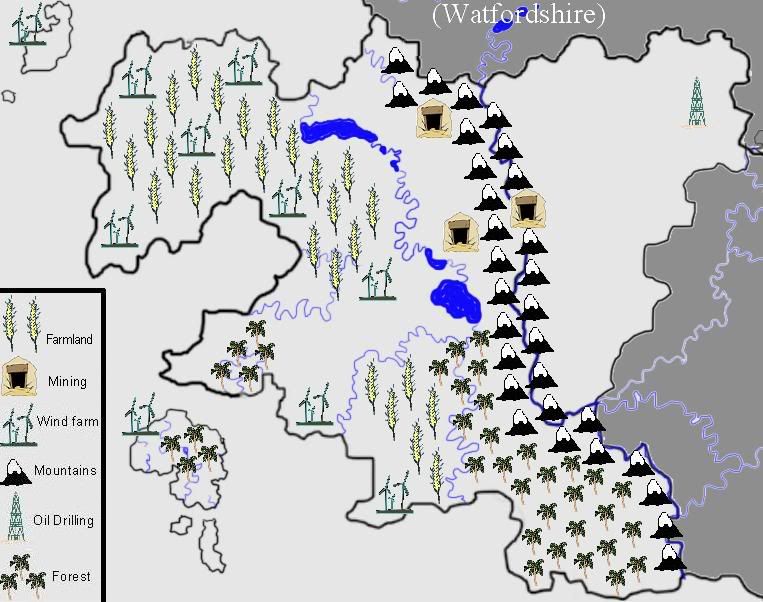Difference between revisions of "Free Outer Eugenia"
| Line 21: | Line 21: | ||
The Outer Eugenian climate is subtropical and it's most notable geographical features are the Big Rock Candy Mountains that mark Outer Eugenia's western frontier and the Great Eugenian Rain Forest in the south. | The Outer Eugenian climate is subtropical and it's most notable geographical features are the Big Rock Candy Mountains that mark Outer Eugenia's western frontier and the Great Eugenian Rain Forest in the south. | ||
| − | |||
| − | |||
==Population Centers and Transport Hubs== | ==Population Centers and Transport Hubs== | ||
| + | http://img.photobucket.com/albums/v238/prophet4profit/FOErail.jpg | ||
| + | ==Land Use== | ||
http://img.photobucket.com/albums/v238/prophet4profit/FOEmap2.jpg | http://img.photobucket.com/albums/v238/prophet4profit/FOEmap2.jpg | ||
== History == | == History == | ||
Revision as of 19:39, 27 March 2007

| |
| Flag of Free Outer Eugenia | |
| Motto: Autonomy in Organization. | |

| |
| Region | Anticapitalist Alliance |
|---|---|
| Capital | none |
| Official Language(s) | none |
| Leader | none |
| Population | |
| Currency | none |
| NS Sunset XML | |
Contents
Overview
According to the U.N. Factbook, Free Outer Eugenia as a safe, environmentally stunning, socially progressive, economically powerful "Left-wing Utopia" notable for its complete lack of prisons, remarkable for its devotion to social welfare, and renowned for its 'strong anti-business politics' and complete absence of drug laws.
Geography
The Federated Anarchist Communes of Free Outer Eugenia are located in the Anarchist south of the continent of Lesser Aperin. Outer Eugenia is the southern neighbor of Watfordshire and it lies west of Inner Eugenia, Refused Party Program and the Anarchist Federation of Free Soviets. The islands of Sacco and Vanzetti lie 600 kilometers southwest from Outer Eugenia's shore.
The Outer Eugenian climate is subtropical and it's most notable geographical features are the Big Rock Candy Mountains that mark Outer Eugenia's western frontier and the Great Eugenian Rain Forest in the south.
Population Centers and Transport Hubs

Land Use

History
Colonial Eugenia
Eugenia's first contact with a people that deemed the native Eugenian communalist subsistence culture to be 'primitive' occurred sometime in the 1540's. What followed was the usual pattern of false promises, greed, genocide and domination. The visitors brought empty treaties, smallpox laden blankets and square-jawed Jesuits who marched across the land with bible in one hand and sword in the other. Many Eugenians fell victim to the strange diseases that they brought. Many others died defending their land. Some retreated into the jungles, mountains and vast wastelands of Eugenia to take up a guerrilla war for land and liberty that would last for over 300 years. These freedom fighters were joined by bands of escaped slaves who were brought over from Africa to build and work the plantations that had been set up by the colonists.
As the stars of various imperial powers rose and fell, the old Spaniards were displaced by other masters but not much changed until the long sought after source of the gems used in Native Eugenian jewelry was found in the Big Rock Candy Mountains. It was then that the Scramble For Eugenia began in earnest. Many bitter wars were fought amongst the world's imperial powers, and a Free Outer Eugenian Republic was formed by rebel peasants, native insurgents and the various slave revolts in the ensuing chaos. The Free Republic lasted for the better part of a decade until the powers contending for control over Eugenia's resources came to an uneasy compromise. A 100-year monopoly over Eugenia was granted to an international cartel led by the notorious patent medicine conman turned railroad tycoon and beef magnate Augustus Kroc. Kroc then sent his ambitious son-in-law Tiberius at the head of an army of mercenaries and the soldiers of the various powers to take possession of his monopoly.
Faced with the ironclads, Gatling guns and other superior arms of an industrial war machine, the machete and musket wielding defenders of the Free Republic were brutally crushed. The rich planters who had fled Eugenia returned to their estates as another generation of freedom fighters retreated into the mountains and jungles.
Acting as an agent of Kroc Industrial, Tiberius Kroc (who had taken his father-in-law's name) employed slaves and indentured laborers to mine Eugenia's gems. As slavery fell out of favor in the world and early trade union movements began to win rights for waged labor, Kroc Industrial saw Eugenia as a lawless haven for the employment of slaves and waged semi-slaves to produce cheap goods for the world market. The discovery of oil and heavy metal deposits further spurred KI to develop Eugenia. Tiberius Kroc (who had become the head of KI after the death of his father-in-law) negotiated a 100 year extension on KI's monopoly and moved his corporate headquarters to a fortified base on Vanderbilt Island. He imported masses of impoverished workers to fuel the industrial machine of his corporate fiefdom.With them was bought the germ of revolutionary syndicalism, the seed of Eugenian liberation.
Revolution and Liberation
The Federation of Free Outer Eugenia was declared nine decades ago after the workers of Port Bakunin (then known as New Krocsport) aided by a group of their Shiree comrades expelled the cartel of transnational corporations that had been the unchecked exploiters and oppressors of the people of Outer Eugenia.
The revolution continued for the next fifty years until the whole of Outer Eugenia had thrown off the yoke of corporate imperialism, though the old regime had been largely contained in a diminishing sphere of control around Fort Vanderbilt (later renamed Fort Vanzetti) for forty-two years. The revolution was fueled by a fusion of an underground syndicalist labor union (the Eugenian Federation of Workers) that had formed during the years of industrialization and the native uprisings that had been raging since the early years of colonization. The traditional consensus-based collectivism of the Native Eugenians and the anarchist syndicalism of the EFW formed the foundation of the post-revolutionary order.
The Eugenian Social Revolution then spread across the region giving rise to the Anarchist Federation of Free Soviets and the libertarian socialist order of the islands now known as Sacco and Vanzetti.
The University at Port Bakunin
The University was founded by a collective of artists, poets, engineers and philosophers shortly after the revolution to advance the prorogation of the arts and sciences amongst the workers of the Federation. It is for the most part the University that makes Port Bakunin the cultural and intellectual center of Free Outer Eugenia. although there are many other great educational collectives in the Federation, many Outer Eugenians spend at least a year or two as a part of the University at Port Bakunin.
